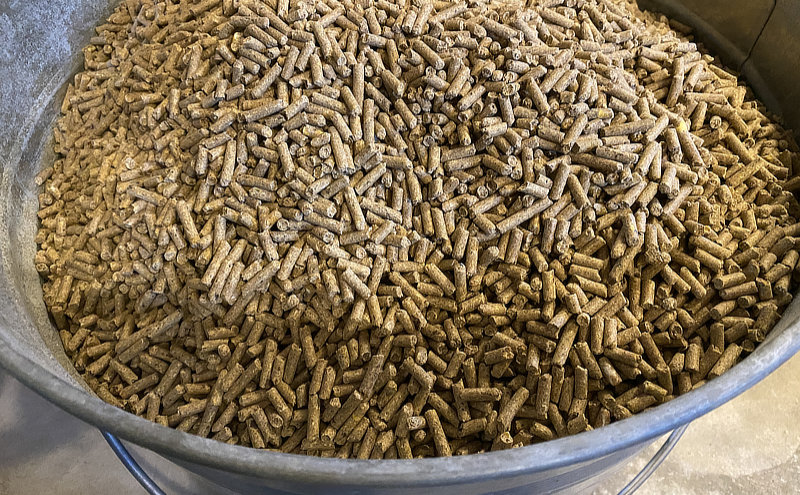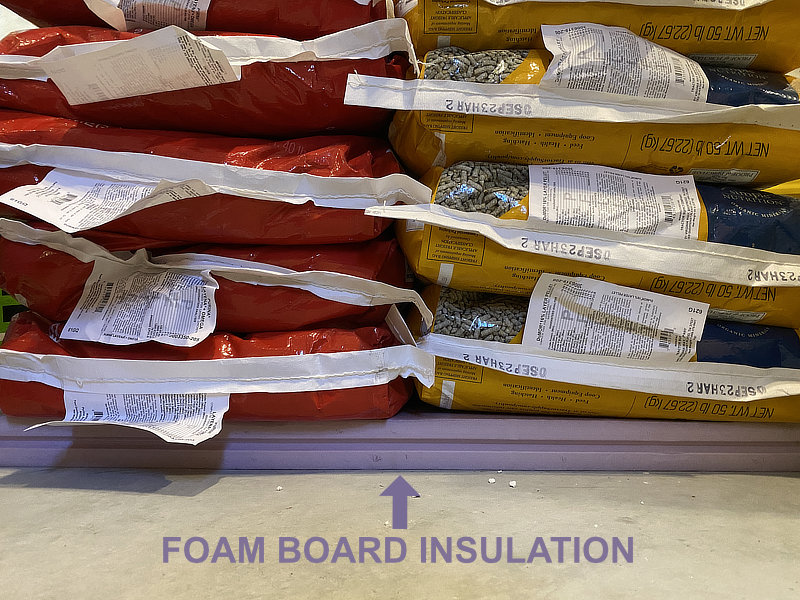Chicken Feed Storage For Winter Months – How Many Bags of Pellets?

Long term chicken feed storage!
Chicken Preparedness ;)
As of this writing, Winter is on the horizon. I like to feel “hunkered down” up here in North Country before the snow flies in earnest. I have calculated how much chicken feed pellets that I will store for winter. That is, how many bags of layer pellets to get my hens through until grasses grows next year.
Right now it’s early October. The leaves have already gone past their peak fall foliage colors here in northern NH. The grasses are mostly yellowed. The chicken’s fenced-in (semi)open-range has diminishing natural foods and bugs for the hens to eat right now.
We always see our first snowfall by end of October. Typically by mid-November we’re accumulating snow such that the ground will not be seen again until April. Grass will start growing by mid-May. That’s a long time for the chickens without natural open range food (and bugs to eat).
So, what to do?
Well, I could do like most others and just buy a 50 pound bag of layer pellets as I need them. A 30 minute trip to Tractor Supply store and I’m all set. Right?
Not exactly. I would rather have stacks of chicken feed bags ready-to-go, stored in my shop building. Enough to get me through. It just makes me feel good (having enough). But that’s just me…
This brings up two questions. How many bags of chicken feed layer pellets do I need for winter storage? What’s the best way to store chicken feed?
How Many Bags (Pounds) Of Chicken Feed For Winter

I used the opportunity to build an Excel spreadsheet (reminiscent of a previous career whereby Excel was a near daily tool!). Anyway, here’s what I came up with…
My birds are ISA-Brown hens. They are a medium size hen. They are prolific layers. One egg a day, pretty much guaranteed (during their prime time of 1 to maybe 2 years). Your hens may be different to an extent (and how much they might eat). But this should give you a clue.
First, weights and measures:
How many cups in a bag of chicken feed
I took out the digital kitchen scale. Zeroed a bowl on top. Filled it with 10 cups of layer pellets (to get a good average weight per cup).
I weighed the two popular brands sold at Tractor Supply. Purina Layena and Dumor. They both weighed nearly identical per cup.
6 ounces per cup.
A 40 pound bag of Purina Layena holds about 107 cups (640 ounces).
A 50 pound bag of Dumor holds about 133 cups (800 ounces).
I recently switched from Purina to Dumor, which costs less. As of this date, about $14 for a 50 lb bag.
How much chicken feed will a hen eat per day?
A few months ago I started keeping track of the date when I opened a new bag of feed. That enabled me to get a pretty good idea how much chicken feed they were eating each day.
Important: Chickens will eat more pellets in the winter because they are not supplementing with open range food. So this factors in to your calculations for winter storage to an extent.
I have seven hens, so I divided everything by seven to get a good average. Here’s what I came up with:
During August, each bird consumed about 0.6 cups of chicken feed per day.
During September, each bird consumed about 0.7 cups per day.
That’s roughly about 1/4 pound per day (each hen).
How much will they be eating during the middle of winter? Well they’re at 0.7 cups/day right now. I might be looking at near a cup a day per bird. Time will tell…
Number of Bags & Pounds – Per Month
Non winter months, about 7 – 8 pounds per hen per month.
Winter months, about 10 – 11 pounds per hen per month. This presumes about 1 cup per day per bird.
My Winter Storage of Chicken feed will provide six months food for seven hens. That comes out to just over (9) 50 pound bags of layer pellets.
How To Store Long Term
It’s really no different than normal “people” food for preparedness. “In a cool, dry place”. Your own environment will vary.
I simply stack the bags on top of a sheet of foam insulation board (cut/saw with sharp knife to size). Readily available at HD or Lowes.

This will keep the bags off the cold concrete – which could otherwise create a moisture problem in that bottom bag.
RODENT PROOF!
Knock on wood, my shop is free of mice. It’s tightly built, so they’re not gettin in *unless they sneak in while the big door is rolled up! ALWAYS keep traps set. This is really the only effective way to battle them.
Should I keep my chicken feed in metal barrels?
Yes, if there’s a rodent problem in your storage area. Place the barrels on wood or something to keep it off direct contact with the floor (prevent a moisture condensation problem). Dump the feed in the barrels.
How Long Will Chicken Feed Last?
Again, depends on your environment. If it’s hot, damp, humid… it’s going to mold much sooner!
I can tell you this… The longest I’ve kept a bag (so far) has been 5 months. The chicken feed bags have a date stamped on an end flap. I had one from May, opened in September, it was perfectly fine.
Feed Cost Per Dozen Eggs Of Production
While I had the spreadsheet open, I figured out how much it’s costing me to get a dozen eggs. Now if you can somehow throw out the cost of materials / building their coop, pen, and fenced range! That leaves you with just the feed (and of course your time which is always free, right?)…
Within a penny, it’s costing me $1 dollar in feed to get a dozen eggs, as of this moment.
[ Read: Chicken Coop Insulation ]
